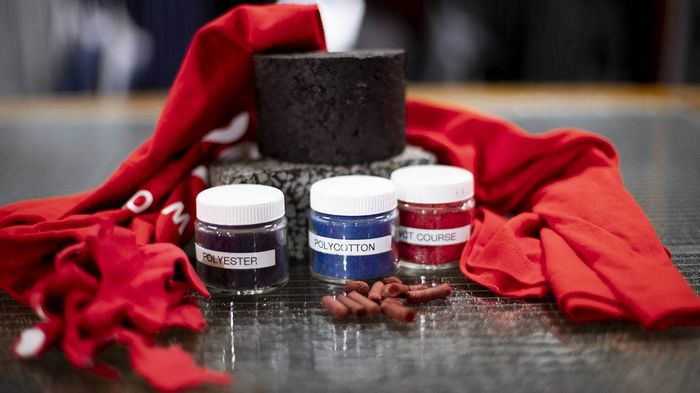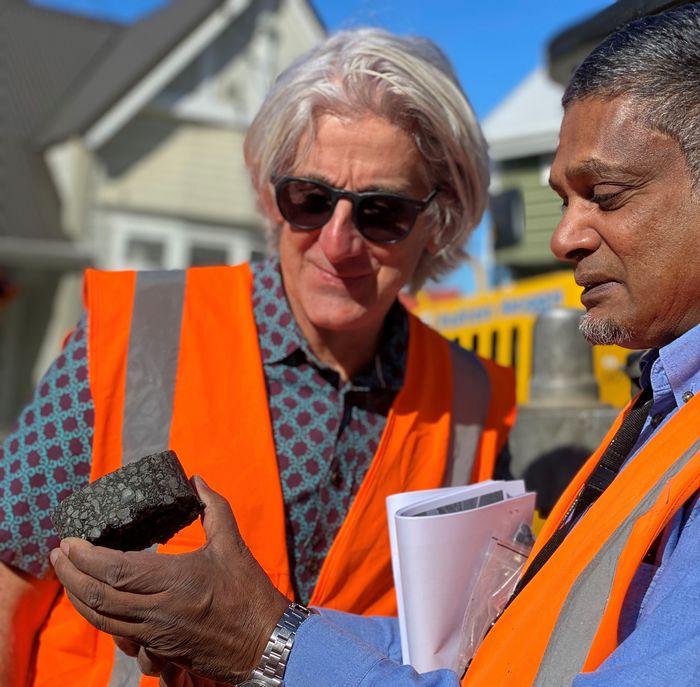Clothes to roads: Innovation explores untapped resource

The roads you drive on could soon be reinforced with unwanted textiles, reducing reliance on imported products and improving road performance.
Vital new funding has been secured to support Scion and its industry partner UsedFULLY, a textile recycling specialist, advance plans to turn unwanted textiles into fibre and use it to reinforce roading surfaces across New Zealand.
Funding from Waka Kotahi and MBIE’s PreSeed Accelerator Fund is enabling Scion and its research partners to derisk technology that Scion has developed so it can be commercially adopted by UsedFULLY to produce a roading additive product, StrengthTex.
A roading trial last year led by UsedFULLY and Wellington City Council tested StrengthTex using asphalt – a first for New Zealand. The new research will explore a fuller range of applications including its compatibility with chip seal. Currently 25% of New Zealand’s roading network uses asphalt, with chip seal applied to the remaining 75% of roads.
Scion’s portfolio leader for Distributed and Circular Manufacturing, Marc Gaugler, says the research is the next critical step needed to prove the technology’s viability as a roading performance-enhancing additive.
“We have been working with UsedFULLY for many years now as part of efforts to create a circular pathway for unwanted textiles. Reusing the fibres in roading will reduce the country’s reliance on imported products and improve the performance of our roads.
“Support from Waka Kotahi and its Transport Innovation Fund shows that, as an organisation responsible for our country’s roading infrastructure, they are enthusiastic about the potential of the technology and what it can achieve, both for roading and New Zealand’s transition to a circular bioeconomy.”
The StrengthTex technology is seen as an important solution to New Zealand’s problem of textile waste.
New Zealand sends about 220,000 tonnes of waste textiles to landfill each year – about half is carpet, the rest is uniforms and workwear, PPE, linens, furnishings and consumer clothing. Diverting this waste from landfills and using it as a resource could reduce greenhouse gas emissions by about 400,000 t CO2e (carbon equivalent) a year.
Disposal to landfill also comes at significant expense to end users. Currently, millions of dollars are spent disposing of unwanted textiles. Now, with the government planning to raise the waste levy by 2024, the cost of disposal will become more significant and is likely to drive behaviour change, especially for large-scale textile users, such as hospitals and rest homes.
This presents a compelling opportunity for UsedFULLY to commercialise Scion’s refining technology that uses a continuous, solvent-free, scalable process to deconstruct waste textiles and transform them into a new high-value product – an ingredient for roading.
The roading industry currently imports about 100 tonnes of cellulose each year from Europe to use in the roading mix to stabilise it, improve its workability, homogeneity and strengthen the final roading surface. The expectation is that this can be replaced with the recycled textile fibre additive, StrengthTex.

Positive feedback
In April 2022, the first asphalt roading trials were laid in Wellington using StrengthTex. The Terrace between Ghuznee and Buller Streets now incorporates 500kgs of used textiles, conserving approximately 11,725kgs CO2e (carbon equivalent), or the emissions produced by 2.5 cars driven for a year.
It has received favourable feedback from roading contractor Fulton Hogan, which processes about 60% of the bitumen used across New Zealand’s asphalt industry.
However, before the technology can be successfully commercialised and adopted by industry, Scion and its research partner WSP Research will work together on critical de-risking steps that explore the viability to use StrengthTex with chip seal and optimise fibre processing and pelletising at scale for commercial production.
Additional research will examine whether there are any environmental concerns from microplastics or microfibres and demonstrate how there are no negative carbon/greenhouse gas consequences associated with the process and products.
A final research focus will prove that textile asphalt can be recycled by combining it with new asphalt – a requirement by contractors.
When the project is finished, Gaugler says it will be at a stage where UsedFULLY and a roading contractor can look at the technical feasibility to conduct a roading trial.
“This research is an example of collaboration that is working to support New Zealand’s move to a low-carbon, circular bioeconomy. We are helping industry address a market need by giving textile waste new life. Ultimately, this will provide a sustainable business opportunity.”
StrengthTex is the first of a number of industrial-scale solutions developed from unwanted textiles by UsedFULLY.
UsedFULLY co-founder Peter Thompson says its success comes down to fantastic collaboration and the expertise and enthusiasm of each of the partners involved.
“The technology not only provides a fit-for-purpose product for our roads and construction industry, it also supports organisations to take action on climate change by diverting their unwanted textiles from waste into local, real-world solutions.
“By targeting commercial linen and clothing suppliers who are highly incentivised to ‘do better’ with their waste, such as hospitals, prisons, retirement homes, hotels and laundries, we can establish a secure, homogenised, high-volume supply that will be easy to sort – saving more than 37,000 tonnes of commercial textile waste in New Zealand each year.
“This is an exciting opportunity, and we know the world is watching.”
